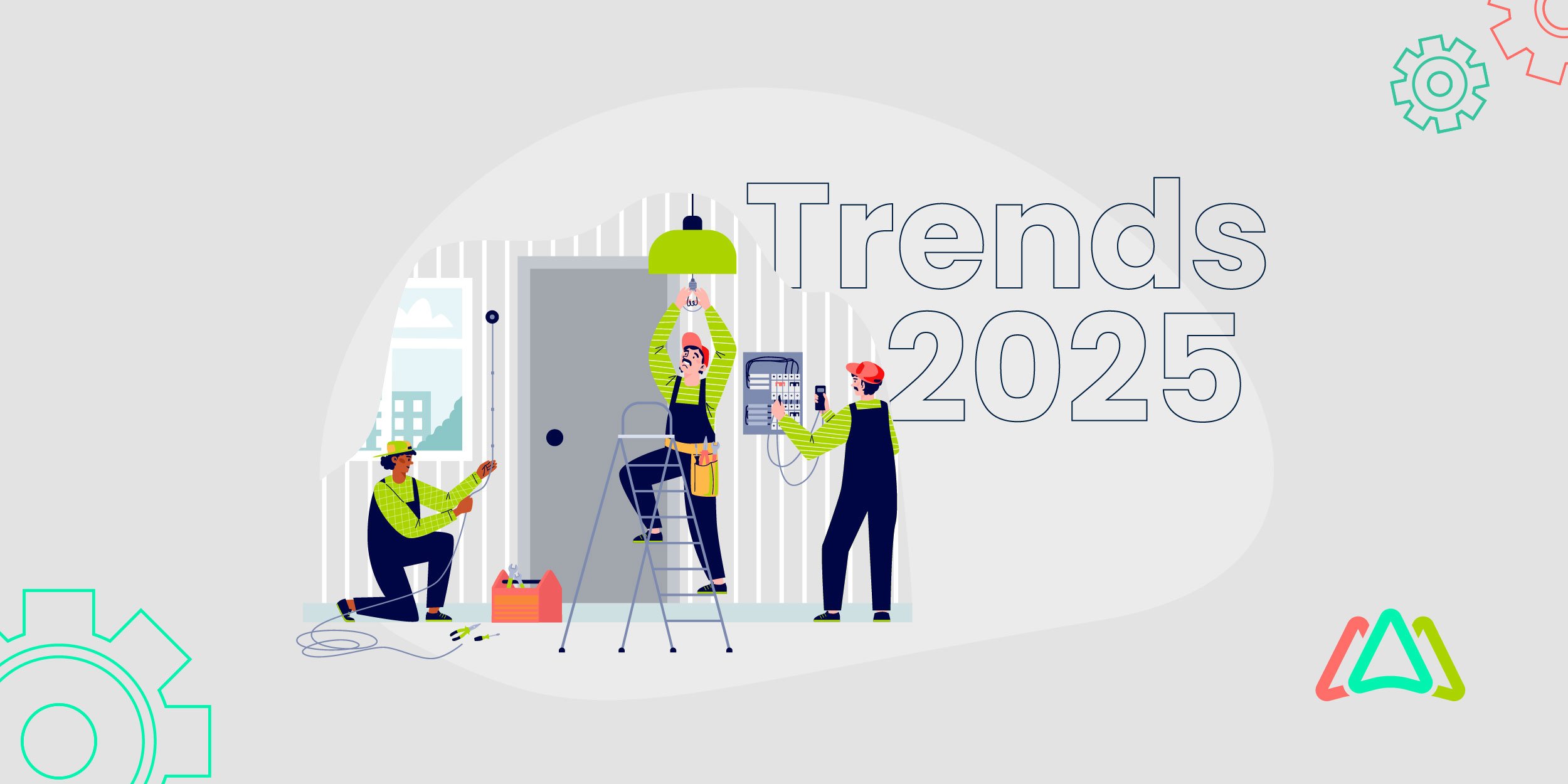
Hot Facility Maintenance Trends for 2025
Facility management has undergone a significant transformation in recent times. Take, for example, a global corporation that has deployed an Integrated Workplace Management System (IWMS) across its extensive real estate portfolio. By going digital, the company reduced operating expenses by 25% and improved workspace utilization by 15%, underscoring the importance of technology.
The role of Facility Managers is also changing. What was once a nuts-and-bolts job of maintaining the status quo now serves as a linchpin for driving advanced technology integration, sustainable practices, and organizational resilience. The burning question for today’s facility managers is: Are you prepared for the changing role? This article examines the latest and most innovative trends in facility maintenance. It provides you and your organization with insights that will keep you ahead of the curve and help you make informed decisions for a smooth-running operation.
Smart Technology & Data Integration
As organizations leverage AI, IoT, digital twins, and predictive analytics to stay ahead of the competition, smart technologies remain paramount.
Here’s how it works: sensors gather real-time information on everything from energy usage to machine performance. AI then analyzes this data, identifying patterns and predicting potential issues before they lead to downtime. Digital twins, the virtual equivalent of physical assets, enable facility managers to experiment with solutions and optimize operations without disrupting the real world.
The result? Fewer surprises, lower maintenance costs, and a more efficient facility. No more panicking about repairing sudden malfunctions. You’re always a step or two ahead.
Smart technology is more than a trend; it is the future of facility management.
Sustainability & ESG Compliance
An ESG-compliant facility is one that not only meets legal standards for compliance but also takes the morally and economically right approach. An alignment with Environmental, Social, and Governance (ESG) standards indicates that the company is committed to responsible behavior.
Environmentally, it means committing to reducing energy waste, mitigating emissions, and practicing sustainability. Socially, this means ensuring that workplaces are safe, that fair labor practices are observed, and that communities are positively impacted. Governance aims to ensure transparency, accountability, ethical leadership, and compliance with the law. The implementation of sustainability helps your company be recognized for its values and demonstrates that sustainability matters to consumers.
People are watching. Is your facility making the world a better place?
Workplace Transformation & Hybrid Operations
Hybrid work became the norm in the workplace and business due to the COVID-19 pandemic. A hybrid model blends remote and in-office work, keeping employees flexible while still standardizing a degree of cohesion across the organization. By late 2024, approximately 28% of workers in Britain were engaging in hybrid work. This new reality has forced companies to adapt and build out office spaces that cater to the need to address both remote and in-person work styles.
The challenge for organizations entering 2025 will be to ensure that transformations are not solely driven by operational requirements but also account for employee preferences, with the aim of enhancing workplace productivity, well-being, and adaptability in an increasingly agile business landscape.
Integrated Facilities Management (IFM) & Automation
In the past, managing a facility meant coordinating multiple vendors, systems, and service providers, including one for cleaning, one for security, and another for maintenance.
With IFM, all systems, including maintenance, security monitoring, and energy management, run on a single, unified platform. Aided by automation, the system can schedule repairs and track performance, even identify issues before they occur, all without human involvement.
In this way, facility teams can spend less time negotiating service contracts and more time focusing on strategy and long-term improvements.
Cyber-Physical Security Integration
“A chain is only as strong as the weakest link.” Nowadays, that weak link isn’t the broken lock or the overpaid security guard who can’t keep their eyes open; it’s a hacker thousands of miles away, taking advantage of vulnerabilities in businesses’ cybersecurity.
Security isn’t just fences and cameras. Smart access controls, surveillance systems, and facility management software, all of which are Internet-accessible, can rapidly escalate a cyberattack into a physical breach. This is why organizations combine cybersecurity with physical security for a seamless, impenetrable barrier.
This means:
- Security systems are also encrypted to prevent unauthorized access.
- Real-time detection of risks from both the physical and digital worlds through various AI-powered threat detection.
- Connecting IT and security teams for 24/7 availability, ensuring nothing falls through the gaps. With these systems in place, you can rest assured that your database is secure.
Augmented & Virtual Reality for Maintenance

Gone are the days of trial and error. Like many manufacturers today, Boeing is leveraging Augmented Reality (AR) and Virtual Reality (VR) to revolutionize how technicians learn and work. With the ability to train in immersive, hands-on simulations instead of riffling through manuals or videos, they are learning complex repairs without worrying about making mistakes in the real world.
AR-enabled smart glasses can provide step-by-step instructions overlaid directly on the equipment on-site, walking technicians through the process in real-time. Need expert help? A remote expert can see what the technician sees and guide them in real-time, reducing mistakes and increasing productivity.
Blockchain for Transparent Asset Management
Ever had a contractor tell you they replaced something but can’t find the receipt? Or did a supplier put a shipment on hold for no actual reason? Industries lose time, money, and trust due to lost paperwork, tampered records, and supply chain loopholes.
Blockchain is the solution to this problem; it can provide a transparent database for maintenance logs, equipment history, and supply chains, allowing businesses to track every transaction with 100% accuracy. No missing parts, falsified reports, or dubious invoices; everything is time-stamped. In a trust-based business climate, there is no room for mistakes or excuses.
Robotic and Drone-Assisted Inspections

Why send humans to carry out dangerous tasks when robots can do the job?
If a technician has to climb a 100-foot tower to inspect a fault or squeeze into a confined space to check for damage, one wrong step, and it’s a disaster waiting to happen. Better yet, a drone to climb up that tower in seconds and take high-resolution pictures, or a robot to squeeze into tight places, while the technician safely watches from the ground. This is safer and more efficient.
Edge Computing for Real-Time Analytics
Traditional systems send maintenance data to distant cloud servers for processing, which can cause delays. By the time an issue is detected, it may have already led to costly downtime. However, with Edge Computing, data is processed immediately at the source, right on the equipment or a nearby server. This allows for more accurate predictive maintenance at a lower cost.
Think of this as machines thinking autonomously, capable of making quick decisions without relying on a distant server.
Sustainable Smart Materials & On-Demand 3D Printing
The maintenance of facilities is going green and smart. Dramatic improvements in efficiency are achieved as businesses ditch wasteful practices and turn to sustainable materials and on-demand 3D printing.
Buildings use eco-friendly materials that last longer and reduce energy consumption. At the same time, 3D printing will allow facilities to produce replacement parts on-site, eliminating long wait times and reducing excess inventory.
Instead of wasting resources or waiting weeks for a simple part, facilities can instantly create exactly what they need when they need it.
How to Navigate The 2025 Trends
Facility maintenance is undergoing rapid change, and keeping up with this evolution requires a strategic approach. Here’s a quick guide to stay updated:
Evaluate Your Current Systems
Begin by identifying the target sectors that are missing from your facility’s maintenance activities. Are your processes outdated? Do you experience frequent downtime and breakdowns? This will enable you to prioritize the right solutions based on your current position.
Adopt Smart Technology
After a thorough evaluation, implement Predictive Maintenance, Edge Computing, and Integrated Facility Management (IFM) where necessary to increase efficiency and reduce costs. This approach could be dovetailed with leveraging CMMS Software for facility management in the area of maintenance.
Strengthen Security
Cyber and physical security are increasingly intertwined. Prevent breaches by protecting your facility’s digital and physical infrastructure with AI-powered threat detection, encrypted access controls, and blockchain-backed asset tracking.
Train and Upskill Your Workforce
The best technology is no better than the people using it. Implement AR/VR training, smart maintenance tools, and real-time analytics dashboards to enhance your team's diagnostic accuracy and improve their efficiency.
Build a Scalable, Future-Ready Strategy
Don’t attempt to tackle everything at the same time. Begin with minor, high-impact upgrades, measure the ROI, and scale from there. Finest: Always learn about new trends in your industry
Conclusion: The Future of Facility Maintenance is Here
In 2025, facility maintenance is not just about repair. It’s about preventing breakdowns before they happen, maximizing efficiency, and proactively addressing risk. Through innovations like these, resilient companies are getting ready to reap cost savings, increased uptime, and greater safety.
However, technology alone isn’t enough. Success depends on strategy, smart adoption, and continuous learning. Companies that evaluate their current systems, invest in the right tools, train their workforce, and scale strategically will lead the way.
The question is no longer whether facility management is evolving; it’s whether your facility is evolving with the latest technology.
TABLE OF CONTENTS
Keep Reading
Spare parts management within maintenance can make the difference between a problem-free ...
16 Dec 2025
Every maintenance team eventually faces the same question: When should we repair, and when ...
12 Dec 2025
Enterprise Asset Management (EAM) software has become a cornerstone for organizations aiming ...
12 Dec 2025
Unexpected equipment breakdowns can disrupt operations, increase repair costs, and reduce ...
11 Dec 2025
Businesses are always looking for ways to improve efficiencies, reduce costs, and improve ...
9 Dec 2025
The longest U.S. federal government shutdown to date lasted 43 days, beginning on October 1, ...
5 Dec 2025
Every maintenance professional faces it sooner or later — that critical time when an aging ...
18 Nov 2025
The term 'best' is often used loosely, without a clear understanding of its context or ...
14 Nov 2025
In the not too distant past, maintenance strategies have been defined by reaction—fixing ...
13 Nov 2025
Tax season is the time of year that often sends a ripple of anxiety through many of us. The ...
11 Nov 2025
Selecting a Computerized Maintenance Management System (CMMS) can, at first glance, be an ...
4 Nov 2025
In healthcare facilities, equipment uptime involves more than achieving operational ...
31 Oct 2025
Companies are subject to economic ups and downs, also known as economic volatility. Today, ...
30 Oct 2025
Maintenance challenges are a constant struggle, with unplanned downtime costing manufacturers ...
27 Oct 2025
Last winter, a maintenance technician at a U.S. paper mill ignored a predictive alert that ...
10 Oct 2025
Many organizations proudly say they “have a CMMS,” but ownership alone doesn’t equal ...
9 Oct 2025
Every maintenance team is under pressure to do more with less. Unplanned downtime is often ...
7 Oct 2025
The implementation of simple, yet powerfully effective, checklists has repeatedly ...
3 Oct 2025
In manufacturing, every second counts. When production stops, whether due to scheduled ...
2 Oct 2025
The increasing cost of maintenance, lack of accountability, and siloed systems leave many ...
30 Sep 2025





